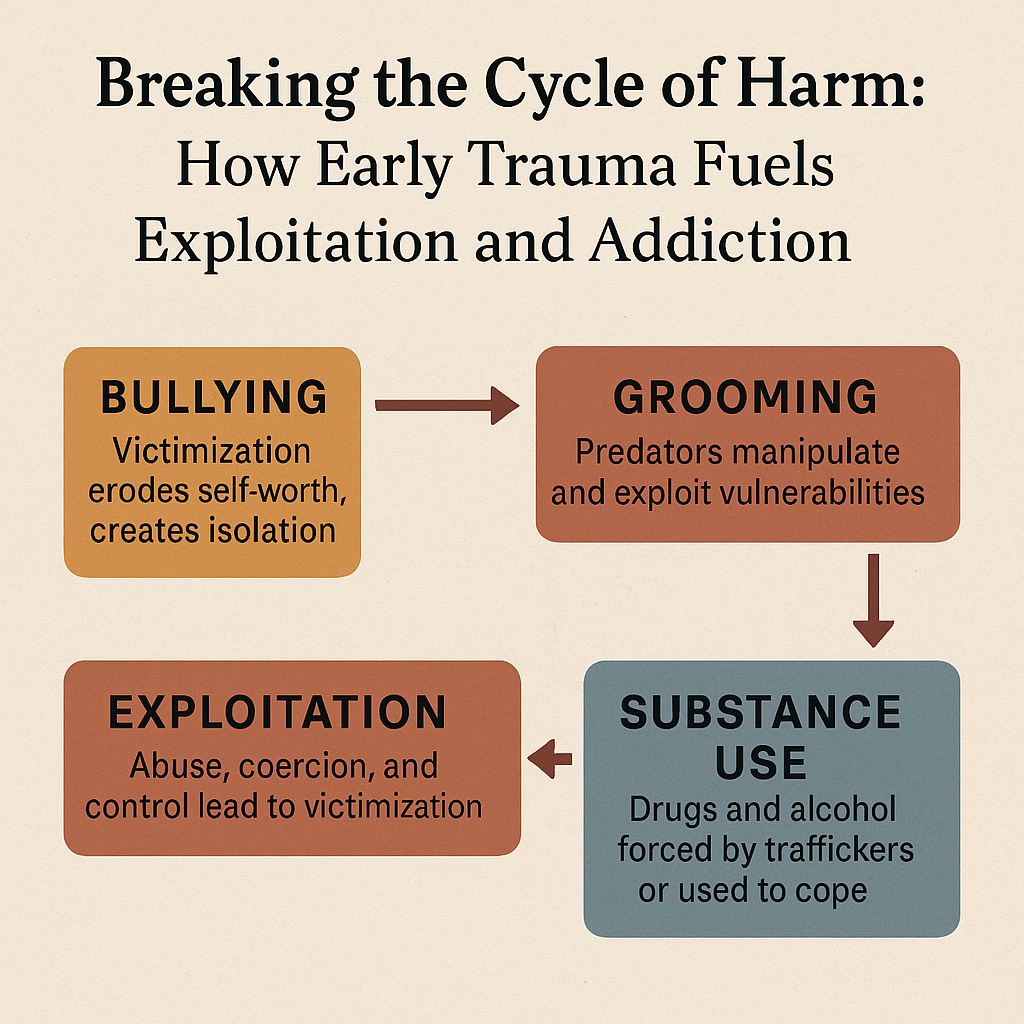October reminds us of many overlapping landscapes of vulnerability; from Domestic Violence Awareness Month to National Bullying Prevention Month to National Substance Abuse Prevention Month; yet what often goes unseen is how these threads link together: how childhood bullying and grooming set the stage, and how exploitation and substance use can follow in turn. For CASH’s mission, that linkage is crucial: the women we serve often carry a history of layered harm, not just a single moment of exploitation.
Bullying and Grooming: Early Vulnerabilities
Research shows bullying is a pervasive experience. One meta-analysis found that about 30.5 % of adolescents across 83 countries reported being bullied. PACER Center+1 In the United States, about one in five students report being bullied. PACER Center Far from being “just childhood stuff”, the psychological toll of bullying is profound: a large survey of 95,545 students found that those who had experienced bullying were 3+ times more likely to have emotional/behavioral problems, anxiety, sleep issues, or markers of PTSD; with much higher risks for severe victims. arXiv
At the same time, grooming, the process through which perpetrators gradually build trust, manipulate, isolate and exploit young people, plays a central role in preparing children for sexual exploitation. A recent study of Spanish university students found a grooming prevalence of 12.2 % in childhood (or early adolescence), with higher likelihood for women and non-binary individuals. MDPI Another review emphasizes that grooming is more than online solicitation: “the literature on grooming is still developing … broadly, it refers to how some perpetrators interact with and engage a child … to enable sexual abuse while decreasing the likelihood of disclosure.” OUP Academic+1
When a young person is bullied, excluded, demeaned, overlooked, or coerced, the effect is to erode self-worth and increase isolation. In that context, adults or older peers who offer attention, flattery, “belonging” can gain powerful entry. One researcher observes that the grooming process thrives when “predators manipulate vulnerabilities and create conditions of compliance and silence”. Our Rescue Once the early groundwork of bullying + grooming is in place, the pathway into exploitation grows more likely.
Exploitation and Substance Use: Trajectories of Harm
For many young women, the journey from childhood vulnerability to adolescent or adult exploitation is rarely linear or simple. The same tactics used in domestic violence; isolation, shame, manipulation, show up in commercial sexual exploitation. The work of psychologist Chitra Raghavan emphasizes how coercive control, in intimate partner violence and in trafficking relationships, uses micro-regulation, threats, induced dependence; and that these dynamics overlap across domains of bullying, grooming and adult violence.
Once exploitation begins, substance use often becomes part of the story; sometimes before, often during, and frequently afterwards. A review from the RAND Corporation found that “sex trafficking and substance use disorders commonly co-occur … some individuals with SUDs are expressly targeted by traffickers, others are coerced into substance use while being trafficked or turn to substances to cope with the trauma of trafficking and exploitation.” RAND Corporation A qualitative study of service-providers working with survivors of sex trafficking described substance use as “a tactic, a risk factor, and a potential trauma bond.” OUP Academic
In fact, survivors themselves and policy briefs emphasize how traffickers use drugs as means of control; to blur consent, to induce dependence, to trap someone financially or emotionally. Human Trafficking Institute+1 Meanwhile, for survivors who were groomed or bullied early, substance use may begin as a coping mechanism for unhealed trauma, which then increases the vulnerability to being exploited by predators who look for that very combination of trauma + substance use + isolation.
Why this matters for CASH’s mission
At CASH, our core belief is that healing must be survivor-led, trauma-informed, and holistic. Recognizing the full arc of this journey; from early bullying, through grooming, into exploitation, and into substance use, is key for several reasons:
- Prevention and early intervention: When we talk about preventing commercial sexual exploitation, we cannot start only at “teen trafficking.” We must engage earlier: bullying prevention, safe peer relationships, self-worth building in childhood and adolescence, and education around grooming signs and healthy relationships.
- Trauma-informed support: For many women we serve, substance use is not simply a “bad choice” but part of the survival story. Understanding how drugs were used by exploiters, or how they became coping tools, helps us meet people where they are rather than treat the substance use as separate from the exploitation.
- Peer-led empowerment: Those with lived experience of bullying, grooming, exploitation, and substance use can bring unique insight. Their narratives help dismantle shame, build trust, and connect with women who may feel “too damaged” to get help.
A quote to hold:
As Raghavan notes:
“Victims of sex trafficking frequently describe feeling powerless long before the abuse began, yet their isolation, shame and trauma are treated as separate issues rather than as connected vulnerabilities.” (Raghavan, paraphrased)
And from service-providers:
“Drugs can be a great coercion… substance use serves not only as risk factor but as trauma bond between victim and exploiter.” OUP Academic
Thus, the layered nature of harm; bullying → grooming → exploitation → substance use, is not a straight line for everyone, but the connections are clear and significant.
In this October, as we observe Domestic Violence Awareness Month, Bullying Prevention Month, and Substance Abuse Prevention Month, we’re reminded that the mission of CASH is perfectly aligned with this intersection. The work is not siloed: early prevention, trauma-informed support, peer leadership, and substance use harm reduction all co-exist in the same continuum of vulnerability and recovery.

